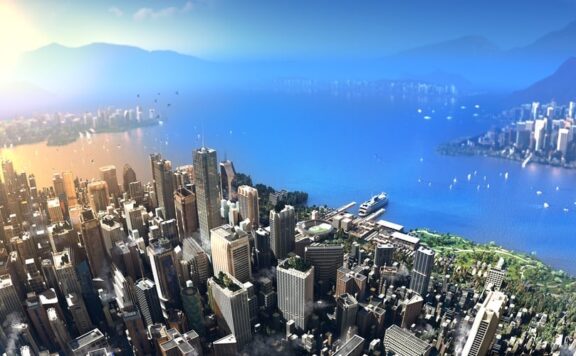After more than three years, the low hanging fruit for Cities: Skylines’ city building to expand to have all been plucked away by the steady stream of expansions that followed its release. That hasn’t made expansions like Green Cities and Parklife interesting, but they’re not as showy and engaging as dropping an asteroid on a part of town you’re not so fond of anymore.
It’s been a while since I really spent a lot of time with Cities, but it feels like Industries takes a fundamentally different approach to what’s been in the previous expansions. Where things like transforming your cities to green energy and sustainability or encouraging hotels and tourists to come to your city have predominantly been about zoning and setting policies, occasionally dropping special buildings into the mix to lay the foundations for something new, Industries pushes you to take control and really build your city into an industrial powerhouse of your own.
It’s really all about letting you micromanage and customise the industrial side of your city, which has largely been neglected since launch. You’ve always been able to create districts and then assign them a particular specialisation to make use of the nearby natural resources, but then it’s all been down to zoning for industry and waiting to see businesses move in. Industries’ new systems live alongside the districts and zoning of old, so you can blend the two together or hive of a new part of the map specifically for your new endeavour.

The first thing you have to do is create an industrial zone, painting it onto the map in a similar way to the existing districts. In fact, it’s a new option under the same districts and areas tab, which took me far too long to realise. Once done, you need to head over to the Rubbish & Industry tab (obviously), and then start laying your specific buildings.
Across forestry, farming, ore and oil – the same four natural resources industries already relied on – you start off placing a hub, then add extractors, processing plants and finally factories and unique one-off buildings to turn all of that into things to sell. Again, you can just drop these in alongside existing logging plants and box factories, but you’ll get by far the most out of it if you really dig in and combine it with a custom build road network. Retrofitting structures into an existing road network is tricky at the best of times, but here they’re often large, bulky and can be quite awkward to fit in if you’ve got a tightly packed set of roads.
It’s a sizeable investment as well, and to level up requires for you to create and fill a certain number of job slots and profit from the system. This isn’t something you can do right out of the gate, but every city in this game is a gradual escalation. Persist, level up, and you’ll go from a furniture factory and bakery through to electronics factories and other luxury goods. It’s weird that you can only build one of each of these, but these are the tail end of your specialisation.

Around this core system, Industries has thrown in a ton of other new features, some complimentary, others seemingly a bit standalone. Warehouses can be used to store finished goods while there’s a new cargo airport for things to come in and out of your city. A range of new policies can allow workers’ unions, work safety, add city-wide Wi-Fi and more. The postal service feels weirdly unrelated to all of these, being crammed in under the same section as other public transport methods. It’s as simple as dropping a few sorting and post offices around and letting yet another flotilla of little vans and trucks clog up your roads.
My main problem with Cities: Skylines now is that it’s starting to feel some of the bloat of years of additions. It’s had a ton of fantastic additions like the added guiding lines when layout your road network, being able to zoom in and rename individual roads and fiddle with traffic lights and stop signs, but that adds a lot of visual noise. Industries is, as you might have gathered, another offender in this regard. All of the new features are tucked away in repurposed menus and areas, with tiny little buttons to try and filter the myriad of options. The fact that districts and industry areas can overlap also means that their names and symbols can overlap. It’s getting to the point that Colossal Order will need to rethink their UI as a whole or find a better way of adding new systems into the game.

No paid expansion goes out without a free update to go alongside it, and in this instance all players have gained the ability to place toll booths and implement road tolls. Sadly you can’t place these over or upgrade existing roads – the game kind of treats them as buildings that happen to be roads, as opposed to roads that happen to be buildings – and they need to be on land as opposed being able to put them on a bridge, making them difficult to retrofit into your road network. More naturally, you can designate zoned buildings as being historical, preserving their style as the city evolves around them.
Though I’ve got a fair few criticisms, Industries feels like a worthwhile addition to Cities: Skylines, taking a long overlooked side of the game’s city building and adding a lot more depth and nuance. The fact that it gives you so much direct control over the actual buildings and not the foundations your city provides could be a new direction for the game to explore more in future.


